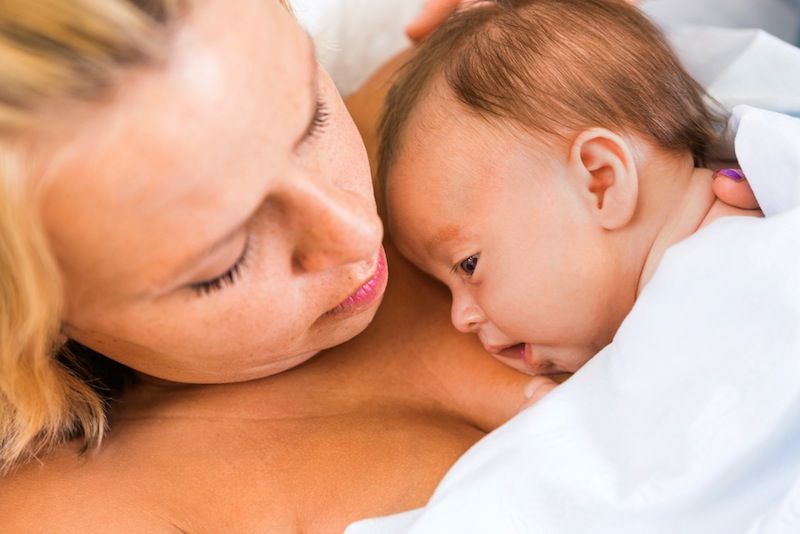Moms' Beneficial Vaginal Microbes Given to C-Section Babies by New Method

In a new procedure, doctors wiped down the skin of newborns delivered by cesarean section with a gauze carrying their mothers' vaginal fluid.
The doctors found that this was a successful way to transfer beneficial microbes from pregnant women to their infants, a new pilot study suggests.
This small study showed that this swabbing procedure, known as vaginal microbial transfer, can safely and effectively change the microbial communities of babies delivered by C-section to make them more closely resemble those of vaginally born babies, said José Clemente, an assistant professor of genetics at the Icahn School of Medicine at Mount Sinai in New York City and a co-author of the research, published today (Feb. 1) in the journal Nature Medicine.
This is the first time such a procedure to manipulate the microbial communities, or microbiomes, of newborns has been tried in humans, although it has been previously shown to work in mice, Clemente said.
A baby's method of delivery is known to influence the microbial composition found on the newborn's skin and in his or her intestinal tract. This early microbial community in newborns may play a role in developing a healthy immune system, and previous research has shown a link between babies delivered by C-section and an increased risk of obesity, asthma, allergies and immune deficiencies compared with babies delivered vaginally, the study said.
In this new study, the researchers collected samples from 18 newborns and their mothers. Seven of the babies were born vaginally, and 11 were delivered by C-section. Four of the newborns born by cesarean section were swabbed with a piece of gauze that had been placed inside the mother's vagina an hour before her C-section.
To transfer the microbes, within a minute or two of the newborns' births, the researchers swabbed the babies' mouths, faces and skin all over their bodies with the gauze for about a minute. [Body Bugs: 5 Surprising Facts About Your Microbiome]
Sign up for the Live Science daily newsletter now
Get the world’s most fascinating discoveries delivered straight to your inbox.
Restoring microbes
Then, six times during the babies' first month of life, the researchers collected bacterial samples from the newborns and their mothers from locations on their skin, mouths and bottoms.
Tests showed that the maternal vaginal fluid is dominated by the Lactobacillus bacteria, Clemente told Live Science. And results from the babies showed that Lactobacillus was also present during the first week in infants born vaginally and the infants born by C-section who were swabbed with vaginal fluid, and then its levels decreased, he said.
Swabbed infants were also found to develop the same bloom of a bacterium called Bacteroides seen in the vaginally delivered infants during the first two weeks of life, and levels of this bacteria were still present for up to one month, Clemente said.
Neither of these two types of bacteria was found in babies born by cesarean who were not swabbed, the study showed.
Early exposure to Lactobacillus and Bacteroides has been associated with healthy immune system development, and it may give the newborns' systems a first impression of how to respond to good and bad bacteria in the future, Clemente noted.
The fact that swabbing the newborns for one minute with vaginal fluids worked to transfer some maternal bacteria to the babies was very exciting, Clemente said. It helped to demonstrate that the procedure is an approximation of a vaginal delivery that can partially restore newborns' microbiomes, he said.
But the length of time that a baby delivered vaginally spends in its mother's birth canal, exposed to her microbes, is much longer than one minute. Moreover, labor itself is much more than a transfer of microbes from mother to infant — factors such as the hormones released when a woman gives birth cannot be replicated in the swabbing procedure, Clemente explained.
He said the next steps in the research, which are currently underway, are to continue monitoring these 18 infants and their mothers over a period longer than one month, to evaluate whether the differences in microbial composition still hold true.
Eventually, it also would be important to target populations at risk for asthma, allergies and obesity, and to observe whether performing the swabbing procedure in babies born via C-section produced a change in these health outcomes for those groups, Clemente said.
Those types of studies are still at least five years away, he said. If that research were to demonstrate improved health outcomes, it could take another 10 to 15 years for vaginal microbial transfer to be approved as a new procedure and for the techniques used to be refined to improve the delivery of bacteria to newborns, Clemente said. [7 Baby Myths Debunked]
In an editorial also appearing in Nature Medicine, Dr.Alexander Khoruts, a gastroenterologist at the University of Minnesota, said that the new study has taken an important first step toward developing a new procedure.
The study was extremely small and lasted for only one month, noted Khoruts, who has who has studied gastrointestinal bacteria.
The new findings could lead to the development an intervention that may someday enhance the introduction of the newborn to microbes and facilitate a lifelong healthy relationship with them, Khoruts said.
Follow Live Science @livescience, Facebook & Google+. Originally published on Live Science.
Cari Nierenberg has been writing about health and wellness topics for online news outlets and print publications for more than two decades. Her work has been published by Live Science, The Washington Post, WebMD, Scientific American, among others. She has a Bachelor of Science degree in nutrition from Cornell University and a Master of Science degree in Nutrition and Communication from Boston University.












